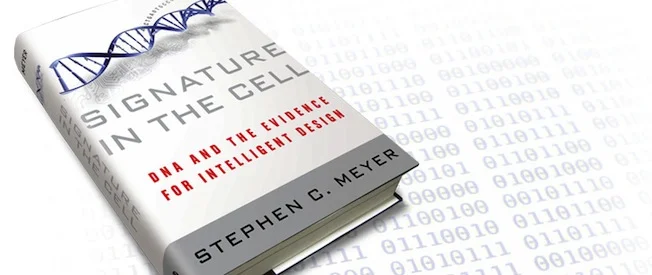 An unusual ability to explain complicated scientific theories and describe intricately designed and nearly inconceivably minuscule parts of cells and DNA and genomes in language which a non-scientist with perhaps a college course in biology can understand makes Stephen C. Meyer a unique author, one who has written a compellingly fascinating book titled Signature in the Cell.
Written to defend Intelligent Design [ID], the book begins with a brief description of Darwinism, DNA, and ID. After a chapter on the work of Watson and Crick and their unraveling of the double helix construction in DNA, Meyers writes brief histories of many theories propounded through the centuries to explain the origin of life on earth using successive theories to describe the fallacies in earlier ones and citations from modern scientists to point out problems in current theories.
An unusual ability to explain complicated scientific theories and describe intricately designed and nearly inconceivably minuscule parts of cells and DNA and genomes in language which a non-scientist with perhaps a college course in biology can understand makes Stephen C. Meyer a unique author, one who has written a compellingly fascinating book titled Signature in the Cell.
Written to defend Intelligent Design [ID], the book begins with a brief description of Darwinism, DNA, and ID. After a chapter on the work of Watson and Crick and their unraveling of the double helix construction in DNA, Meyers writes brief histories of many theories propounded through the centuries to explain the origin of life on earth using successive theories to describe the fallacies in earlier ones and citations from modern scientists to point out problems in current theories.
Adding information to matter and energy in order to produce life creates incomprehensible numbers such as “the probability of finding a functional protein by chance alone is a trillion, trillion, trillion, trillion trillion, trillion trillion times smaller than the odds of finding a single specified particle among all the particles in the universe” page 212.
Using over seven hundred notes and citations and listing nine hundred sources in his bibliography, Meyers documents his information meticulously. Yet he often uses simple illustrations such as passing around a padlock to students in his class and asking them to try in three steps to unlock it. When finally one boy succeeds, at first the students are incredulous over his luck but then gradually realize he has had information from the teacher that they lacked.
Because belief in God as the creator immediately marks any theory or information as unscientific in the minds of many scientists, Stevens carefully avoids using the word “God” until near the end of the book, and he never mentions the Biblical account of creation or his religious beliefs, although he does say he believes in God on page 440.
Readers may find the five hundred pages of the book rather daunting, but persistence will greatly increase their knowledge and understanding of current theories about how life appeared on earth including belief in Intelligent Design.
Stephen E. Meyers PhD directs the Center for Science and Culture at the Discovery Institute in Seattle.

